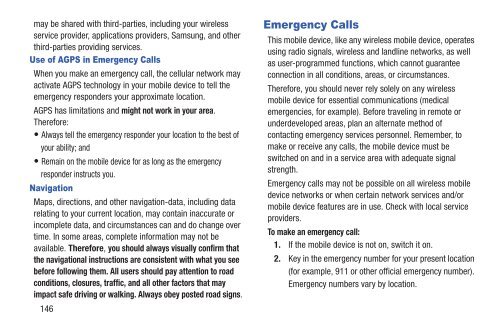Samsung Gusto 2 64MB (Verizon) - SCH-U365HAAVZW - User Manual ver. FB03_F6 (ENGLISH(North America),3.36 MB)
Samsung Gusto 2 64MB (Verizon) - SCH-U365HAAVZW - User Manual ver. FB03_F6 (ENGLISH(North America),3.36 MB)
Samsung Gusto 2 64MB (Verizon) - SCH-U365HAAVZW - User Manual ver. FB03_F6 (ENGLISH(North America),3.36 MB)
Create successful ePaper yourself
Turn your PDF publications into a flip-book with our unique Google optimized e-Paper software.
may be shared with third-parties, including your wireless<br />
service provider, applications providers, <strong>Samsung</strong>, and other<br />
third-parties providing services.<br />
Use of AGPS in Emergency Calls<br />
When you make an emergency call, the cellular network may<br />
activate AGPS technology in your mobile device to tell the<br />
emergency responders your approximate location.<br />
AGPS has limitations and might not work in your area.<br />
Therefore:<br />
• Always tell the emergency responder your location to the best of<br />
your ability; and<br />
• Remain on the mobile device for as long as the emergency<br />
responder instructs you.<br />
Navigation<br />
Maps, directions, and other navigation-data, including data<br />
relating to your current location, may contain inaccurate or<br />
incomplete data, and circumstances can and do change o<strong>ver</strong><br />
time. In some areas, complete information may not be<br />
available. Therefore, you should always visually confirm that<br />
the navigational instructions are consistent with what you see<br />
before following them. All users should pay attention to road<br />
conditions, closures, traffic, and all other factors that may<br />
impact safe driving or walking. Always obey posted road signs.<br />
146<br />
Emergency Calls<br />
This mobile device, like any wireless mobile device, operates<br />
using radio signals, wireless and landline networks, as well<br />
as user-programmed functions, which cannot guarantee<br />
connection in all conditions, areas, or circumstances.<br />
Therefore, you should ne<strong>ver</strong> rely solely on any wireless<br />
mobile device for essential communications (medical<br />
emergencies, for example). Before traveling in remote or<br />
underdeveloped areas, plan an alternate method of<br />
contacting emergency services personnel. Remember, to<br />
make or receive any calls, the mobile device must be<br />
switched on and in a service area with adequate signal<br />
strength.<br />
Emergency calls may not be possible on all wireless mobile<br />
device networks or when certain network services and/or<br />
mobile device features are in use. Check with local service<br />
providers.<br />
To make an emergency call:<br />
1. If the mobile device is not on, switch it on.<br />
2. Key in the emergency number for your present location<br />
(for example, 911 or other official emergency number).<br />
Emergency numbers vary by location.
















